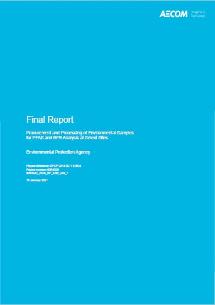Monitoring for per- and poly-fluoroalkyl substances (PFAS) and brominated flame retardants (BFRs) at fire training sites
Summary: Per- and poly-fluoroalkyl substances (PFAS) are a large group of man-made chemicals widely used in industrial and consumer products due to their water and oil resistance, chemical and heat stability, friction reduction and surfactant properties. They can be found in many everyday products, including outdoor clothing and also in fire-fighting foams but can have harmful effects on human health and the environment.

The use of PFAS in fire-fighting foams poses a significant risk to human health and the environment. Brominated flame retardants (BFRs) are also a human health and environmental concern and are used to treat electrical equipment, furniture and textiles, to reduce the risk of fire spreading. The Environmental Protection Agency (EPA) commissioned a pilot study to investigate the presence of PFAS and certain BFRs in potential hot-spot areas, associated with historical and/or recent use of PFAS containing fire-fighting foam and in one pristine area, for comparison. The selected sites were:
1. Dublin Fire Brigade Training Centre (Fire Services training area);
2. Bunclody Fire Station, Co. Wexford (Fire Services training area);
3. Shannon Airport, Co. Clare (Airfield fire training area);
4. Wolftrap Mountain, Slieve Bloom Mountain Range, Co. Offaly (Pristine site);
5. Irving Oil Whitegate, Co. Cork (Industrial fire training area)
A total of 26 primary samples were obtained from these sites including water (seven samples), soil (13 samples), vegetation (five samples) and sediment (one sample), as well as five quality control samples (four duplicates and one equipment rinsate). Adopted screening criteria were exceeded at three sites; Dublin Fire Brigade, Shannon Airport and Irving Oil. This included exceedances of human health screening criteria in three water samples, collected from the Dublin Fire Brigade and Irving Oil sites, environmental screening criteria in four water samples from Dublin Fire Brigade, Shannon Airport and Irving Oil and ecological screening criteria in soil samples at one site, Dublin Fire Brigade. Samples collected from Bunclody Fire Station and Wolftrap Mountain did not exceed the adopted screening criteria. No samples exceeded the adopted screening criteria for BFRs.
This report has highlighted the potential risks posed by use of PFAS containing foams, particularly at fire training sites. The EPA is continuing to work with the Fire Services and other users of PFAS foams, to increase awareness of the risks posed and ultimately to reduce these risks. A guidance document and infographic are being developed on the proper use and disposal of PFAS foams, including a recommendation for PFAS foams not to be used for fire training, as PFAS-free alternatives are available. The EPA is also further investigating the risks posed to human health and the environment through the analysis of samples from a range of water bodies for PFAS.